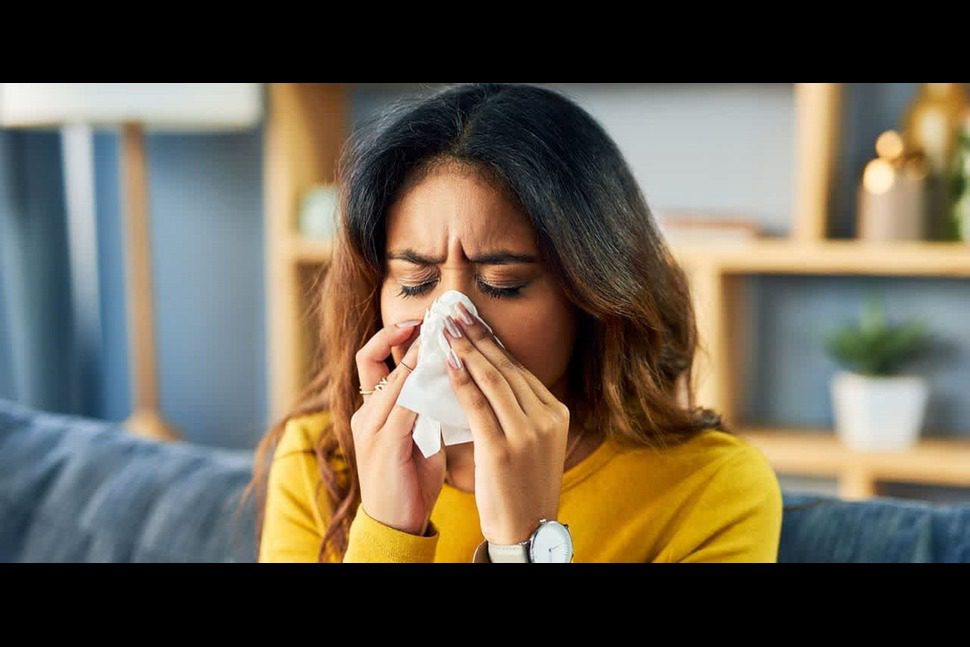
Pumpkin Carving Safety
October 24, 2023
Seasonal Cheer without Fire Fear
November 25, 2023The importance of having an Allergy-Proof Home – with allergy season upon us, you may be one of the 50 million Americans who experience allergy symptoms. When your allergies act up, you could suffer from symptoms ranging from itchy eyes and a runny nose to more severe reactions like difficulty breathing or chest tightness that may require medical treatment.
Your first thought may be to avoid time outdoors to reduce your pollen exposure and the potential for allergy symptoms. However, the culprit may be your home—living spaces often house unwelcome guests like dust mites, mold, and pet dander.
To combat possible allergies, it’s important to get to the source of your symptoms and maintain a clean home environment. With all the tasks that come with taking care of your home and your health, staying on top of spring cleaning can be a challenge. So we’ve created easy guidelines to follow to help minimize your exposure to allergens within your home.
Read on to learn how to remove allergens from each room of your house and prevent them from coming back in.
Living Room
For many people, the living room is the center of the home where they go to unwind or spend time with family. The last thing you want while watching your favorite show or having a family game night is to be interrupted by itchy eyes or uncontrollable sneezing. If you spend a lot of time in your living room, it’s a good idea to pay special attention to making it an allergen-free space.
- Clean Floors
Even in the cleanest homes, it’s easy to bring outdoor allergens in on your shoes or your pet’s paws. It’s possible that your plush carpet or area rug is housing dust that gets kicked into the air whenever someone walks over it.
To help reduce allergens, sweep and clean hardwood floors regularly. The best way to clean your hardwood floors depends on whether your floors are sealed. If a floor is unsealed, using water to clean it could cause the wood to swell and warp. Regularly sweeping and vacuuming unsealed floors keeps them allergen-free without causing water damage.
If you have rugs or carpet, vacuum them weekly with a cleaner that has a small-particle or HEPA (high-efficiency particulate air) filter. You should also deep clean carpets at least once a year to get out deeply embedded pet dander, dust mites, and other allergens.
- Check Filters
Ensuring that your home is properly ventilated is the first step to eliminating allergens from the air. Paper filters that are ordinarily used in furnaces and air conditioners are designed to trap large particles like dust that can accumulate on the motor and fans.
However, particles like mold, bacteria, and certain types of pollen are much smaller in size and can slip through the fibers in regular filters, meaning they get circulated through your ductwork and blown back into your space. To prevent this, make sure you use HEPA filters and replace them regularly. A general rule of thumb is to replace air filters every 90 days.
- Dust Furniture
Furniture can be just as inviting for allergens as it is for you and your family. To prevent dust buildup, you’ll need to dust commonly used living room items—like electronics and furniture—weekly and dust out-of-reach spots like ceilings, corners, ceiling fan blades, and door frames as needed.
To make sure you’re not literally sweeping things under the rug, make sure to use a dusting tool that traps dust as you sweep. This way, you’re not just spreading the dust back into the air and around your house.
Kitchen
With an abundance of food and moisture in your kitchen, it’s an easy place for indoor allergens like mold to live. While mold spores floating in the air can trigger allergic reactions, symptoms worsen when these spores attach to wet surfaces and mold begins to grow. To keep mold from growing in damp or hard-to-reach places, consider prioritizing the following cleaning tasks.
- Clean the Refrigerator
Refrigerators are prone to moisture buildup which can promote mold growth. To prevent mold from growing in your fridge, regularly wipe away excess moisture and make a note to check for and throw away expired food on a weekly basis.
Additionally, the dripping pan is a great place for allergens to live. Regularly empty and clean it out as needed, and remember to replace any moldy rubber seals around your refrigerator door.
- Wash Dishes
Make sure you wash your dishes daily, as mold and food debris can easily build up in your sink. The area under the sink is also a great place for mold to hide. Frequently clean out the space under your sink and ensure that there are no leaks coming from your pipes.
- Clean Cabinets and Countertops
Frequently spraying down and wiping your cabinets and countertops helps eliminate allergens in your home. This could be done as often as every day to wash away food crumbs and reduce the risk of mold growing.
It’s best to use eco-friendly sprays and detergents when cleaning these areas to avoid bringing harmful chemicals near your food. Additionally, heavy detergents filled with chemicals can cause allergic reactions for allergy-prone individuals or those with a previous diagnosis of asthma.
Bedroom
We know you love your bed, but unfortunately, dust mites like it, too…a lot. As we sleep, we shed dead skin cells—which are a dust mite’s favorite bedtime snack. Millions of these microscopic bugs can cozy up in a single mattress and leave droppings (gross, we know) causing people to have allergic reactions like skin rashes, sneezing, and congestion. Dust mites are a real problem, so be sure you don’t skimp out on deep cleaning the bedrooms in your house.
- Wash Bedding
Bedding accessories are a great place for microscopic dust mites to burrow. Since we spend nearly one-third of our lives in bed, maintaining clean bedding is essential to reduce our exposure to dust mites and prevent potential allergic reactions.
Adding a few additional layers of protection to your mattress and pillows, like dust-proof or allergen-blocking covers, makes it easy to keep your bed free of dust mites. Additionally, make sure to wash all bedding accessories and sheets weekly in hot water.
- Replace Old Mattresses
Did you know that the typical used mattress can house as many as 10 million dust mites? If you suffer from allergies, it may very well be time to replace your mattress.
Dust mites on a mattress can significantly affect those with asthma and could pose dangerous health risks like difficulty breathing, chest tightness, and trouble sleeping due to shortness of breath.
- Clean Curtains and Blinds
Curtains and blinds are common places for dust and other allergens to accumulate, so do your due diligence and clean these regularly. About twice a month, gently vacuum curtains and drapes using a brush attachment at the lowest suction setting.
A hairdryer on the cold setting is also a great way to remove debris from delicate fabrics. Just make sure you vacuum the area afterward to avoid blowing dust into other areas of your bedroom. If you have blinds, use a duster or dust rag to clear away dust that can build up between the panels.
Children’s Room
We love our kids, but let’s face it, sometimes they can get pretty dirty. Cleaning your child’s room should be a priority, as it’s extra prone to housing both indoor and outdoor allergens. We’ve listed a few must-do cleaning tasks for allergy-proofing below.
- Clean Toys
Dust mites, mold, and pet dander often linger on children’s toys, so don’t forget to frequently clean them. This is especially important for small children who have a tendency to touch everything and put toys in their mouth.
You can clean most toys in either the washing machine, dishwasher, or with water and vinegar. None of these methods require harsh cleaning chemicals and are safe for your children.
- Wash Stuffed Animals and Blankets
Children can become attached to a favorite stuffed animal or blanket and may want to bring it along everywhere they go, exposing it to both indoor and outdoor allergens. To keep these items clean and allergen-free, we recommend tossing them in the wash on laundry day or hand washing them regularly.
If a stuffed animal or blanket is old or delicate, use mild detergents with cold water and place it in a garment bag to prevent damage or tears.
- Store Play Items in Bins
When toys sit on the floor or out in the open, they are at higher risk of being contaminated by allergens. To prevent this, encourage your children to store play items in plastic bins when they’re not in use.
Additionally, make sure to declutter play bins every few months and get rid of items that your child has outgrown or no longer uses. This can help prevent the buildup of allergens in the room and make cleaning less daunting.
Bathroom
Deep cleaning the bathroom can feel like a daunting task, but it’s necessary. Bathrooms are breeding grounds for mold since moisture can build up easily, so it’s important to disinfect tubs, sinks, and toilets and eliminate grime to properly allergy-proof your home.
- Scrub Sinks and Tubs
You should scrub your tubs, sinks, showers, and faucets with bleach or bathroom cleaner each week. If you’re not a fan of bleach, making an eco-friendly cleaning scrub from baking soda, castile soap, and essential oils is also effective for removing dirt, mold, and scum from your bathroom.
To prevent mold buildup, get in the habit of wiping condensation from all surfaces with a clean towel after showering or washing your hands in the sink.
- Wash Rugs and Bath Mats
On laundry day, don’t forget to wash any bathroom rugs or bath mats that you use to soak up water. Not only can they collect dust and dirt, but they can store harmful mold as they absorb moisture near the shower or tub. Opting for bathroom rugs that are machine washable will make this weekly task easier.
- Clean Toilets
Frequently scrub any mold away from the plumbing fixtures in your bathroom with bleach or a toilet cleaner. Additionally, ensure there are no plumbing leaks as unattended water spills will create mold.
Pets
Many of us love our pets like our own children and see them as part of the family, so it’s important to eliminate their exposure to allergens. Pets can also bring extra allergens into the house as they shed hair and dander, so you may want to take extra precautions when allergy-proofing your home if you have pets.
- Brush Pets Regularly
Pet hair and dander is a large component of dust, so regularly brushing away loose hair is a good way to prevent allergens from accumulating in your home. Use a pet-specific brush that’s designed to safely clear away excess hair, then properly dispose of it.
- Bathe Your Pet
Bathing your pet regularly helps protect them from allergens that can cling to their fur and washes away excess dander before it accumulates in your home. How often you bathe your pet depends on the length of their fur, their activity level, and whether they have any skin conditions or allergies. Most experts recommend bathing your pet every four to six weeks, but your vet can give you the best advice.
When giving your pet a bath, use lukewarm water and pet-safe soaps and shampoos. You can bathe your pet in a sink, tub, shower, or portable pet tub.
- Clean Pet Toys
It’s important to frequently wash pet toys just like you would for kids. They’ve likely rolled all over your home or the ground outside, collecting both indoor and outdoor allergens along the way.
Be careful with cleaning toys as some may not be dishwasher-safe or machine washable. You should also avoid using harsh chemicals and check for washing instructions on the tag. If a toy doesn’t come with instructions, there are many online pet owner resources that provide step-by-step instructions on how to safely wash toys without exposing your pet to harmful chemicals.
Whether you’re looking to buy, sell or refinance your home, HDA Insurance Brokerage is available to insure your new property; whether an owner-occupied home or a tenant-occupied rental unit. You may obtain a FREE Home Insurance Quote Online when you’re ready.

